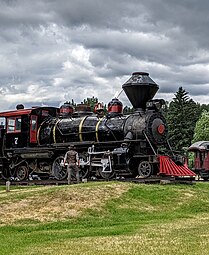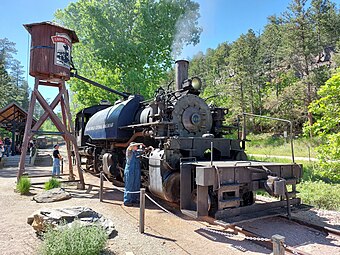Black Hills Central Railroad: Difference between revisions
No edit summary |
No edit summary Tags: Mobile edit Mobile web edit |
||
| (4 intermediate revisions by 3 users not shown) | |||
| Line 1: | Line 1: | ||
{{Short description|Heritage railroad in South Dakota}} |
|||
{{Use mdy dates|date=July 2024}} |
|||
{{Infobox heritage railway |
{{Infobox heritage railway |
||
| name = Black Hills Central Railroad |
| name = Black Hills Central Railroad |
||
| Line 75: | Line 77: | ||
Heckman and Freer proposed a new three foot gauge [[heritage railroad]], using the Keystone Branch, by laying a third rail on five miles of the [[standard gauge]] track. CB&Q was supportive, and the dual-gauge line was constructed from Hill City to a new terminus with a [[wye (rail)|wye]], to be named “Oblivion” about midway along the branch. The choice of narrow gauge was influenced by the availability, also from CB&Q, of a complete 1880s styled "[[Deadwood Central Railroad|Deadwood Central]]" trainset which had been assembled for the [[Chicago Railroad Fair]] of 1948–49.<ref name="Trains_1956" /> This consisted of: |
Heckman and Freer proposed a new three foot gauge [[heritage railroad]], using the Keystone Branch, by laying a third rail on five miles of the [[standard gauge]] track. CB&Q was supportive, and the dual-gauge line was constructed from Hill City to a new terminus with a [[wye (rail)|wye]], to be named “Oblivion” about midway along the branch. The choice of narrow gauge was influenced by the availability, also from CB&Q, of a complete 1880s styled "[[Deadwood Central Railroad|Deadwood Central]]" trainset which had been assembled for the [[Chicago Railroad Fair]] of 1948–49.<ref name="Trains_1956" /> This consisted of: |
||
* [[Colorado and Southern]] Number 9, a [[2-6-0]] built in 1882, which had been named ''Chief Crazy Horse'' for the Fair. |
* [[Colorado and Southern]] Number 9, a [[2-6-0]] built by [[Cooke Locomotive Works]] in 1882, originally as [[Denver, South Park and Pacific]] Number 72, which had been named ''Chief Crazy Horse'' for the Fair. |
||
* Coaches, open observation cars and a [[railway post office]] car of 1880s style, but which had been built new by CB&Q. |
* Coaches, open observation cars and a [[railway post office]] car of 1880s style, but which had been built new by CB&Q. |
||
| Line 89: | Line 91: | ||
== Preserved equipment == |
== Preserved equipment == |
||
| ⚫ | |||
===Locomotives=== |
===Locomotives=== |
||
| Line 103: | Line 104: | ||
* #63, [[EMD GP9]], formerly [[Chesapeake and Ohio Railway]] (C&O) #6178. Operational. |
* #63, [[EMD GP9]], formerly [[Chesapeake and Ohio Railway]] (C&O) #6178. Operational. |
||
* #6657, Whitcomb 80 Tonner, built 1943 as U.S. Army #7379. Operational. |
* #6657, Whitcomb 80 Tonner, built 1943 as U.S. Army #7379. Operational. |
||
<gallery mode="packed" heights="170"> |
|||
| ⚫ | |||
File:Black Hills Central 174x4RP (8078871183).jpg|Locomotive #104 on line. |
|||
File:Black_Hills_Central_110-b.jpg|Mallet locomotive #110 takes on water in Keystone. |
|||
</gallery> |
|||
===Rolling Stock=== |
===Rolling Stock=== |
||
| Line 109: | Line 115: | ||
South of the Hill City depot, a small [[rail yard]] holds a variety of rolling stock, mostly early twentieth century, awaiting restoration. |
South of the Hill City depot, a small [[rail yard]] holds a variety of rolling stock, mostly early twentieth century, awaiting restoration. |
||
[[File:Black_Hills_Central_coache.jpg|thumb|center|Former electric interurban car.]] |
|||
==References== |
==References== |
||
Latest revision as of 22:04, 29 September 2024
| Black Hills Central Railroad | |
|---|---|
 | |
| Locale | Keystone, South Dakota |
| Commercial operations | |
| Name | Keystone Branch of the Burlington Northern Railroad |
| Built by | Chicago, Burlington and Quincy Railroad |
| Original gauge | 4 ft 8+1⁄2 in (1,435 mm) (standard gauge) |
| Preserved operations | |
| Owned by | Black Hills Central Railroad |
| Operated by | Black Hills Central Railroad |
| Preserved gauge | 4 ft 8+1⁄2 in (1,435 mm) (standard gauge) |
| 1957 | Reopened |
Burlington and Quincy High Line Hill City to Keystone Branch | |
| Nearest city | Hill City, South Dakota |
| Coordinates | 43°55′56″N 103°34′24″W / 43.93222°N 103.57333°W |
| Area | 35 acres (14 ha) |
| Built | 1890 |
| NRHP reference No. | 02001768[1] |
| Added to NRHP | February 5, 2003 |
The Black Hills Central Railroad is a heritage railroad that operates in Keystone, South Dakota, United States. The railroad was added to the National Register of Historic Places on February 5, 2003.[1]
It currently operates the 1880 Train on the former Keystone Branch of the Burlington Northern Railroad (BN) between Hill City, South Dakota and Keystone, South Dakota. This railroad line was originally built by the Chicago, Burlington and Quincy Railroad (CB&Q) to serve mining and timber interests in the Black Hills. It reached Keystone on January 20, 1900 and was later used to haul equipment for carving nearby Mount Rushmore.[2]
The Black Hills Central Railroad restores early twentieth century-era locomotives and train cars and has been featured on television shows such as the Gunsmoke episode "Snow Train", General Hospital and the TNT mini-series Into the West. It also appeared in the movie Orphan Train.
Trains operate between early May and early October over the scenic 10-mile (16 km) line.
The South Dakota State Railroad Museum is located adjacent to the Hill City depot, on BHCR land.
History
[edit]In 1956 two steam enthusiasts, William Heckman and Robert Freer, promoted to “have in operation at least one working steam railroad, for boys of all ages who share America’s fondness for the rapidly vanishing steam locomotive.” They soon gathered financial, political and popular support for this venture adjacent to the tourist destination of Mount Rushmore.[3][4] The intention was to have summer steam train operations with 1880-period equipment.
Narrow Gauge
[edit]Heckman and Freer proposed a new three foot gauge heritage railroad, using the Keystone Branch, by laying a third rail on five miles of the standard gauge track. CB&Q was supportive, and the dual-gauge line was constructed from Hill City to a new terminus with a wye, to be named “Oblivion” about midway along the branch. The choice of narrow gauge was influenced by the availability, also from CB&Q, of a complete 1880s styled "Deadwood Central" trainset which had been assembled for the Chicago Railroad Fair of 1948–49.[3] This consisted of:
- Colorado and Southern Number 9, a 2-6-0 built by Cooke Locomotive Works in 1882, originally as Denver, South Park and Pacific Number 72, which had been named Chief Crazy Horse for the Fair.
- Coaches, open observation cars and a railway post office car of 1880s style, but which had been built new by CB&Q.
Additionally, White Pass & Yukon Number 69, an outside-framed 2-8-0 built in 1908 was acquired, to be named Klondike Casey[5][3]
The narrow gauge operation began in 1957 and ran successfully for several years until a decision was made to extend the operation to Keystone, which included a change to standard gauge. The third rail was removed in 1964 (although as of 2022, the abandoned Oblivion Wye rails remain in place), and the locos and rolling stock were eventually divested to other heritage railways: Number 69 went to the Nebraska Midland Railroad in 1973, and then home to the White Pass in 2001. Number 9 went to the Georgetown Loop in Colorado in 1988. As of 2020, Number 69 is operable but has been stored since 2013, and Number 9 is on static display at Breckinridge, Colorado, having suffered mechanical damage in 2006.
Standard Gauge
[edit]BHCR gradually acquired its current range of locomotives and rolling stock, and continued operations over the full length of the branch until the 1972 Black Hills flood destroyed the last three miles of track into Keystone.[6] Burlington Northern relocated and rebuilt two miles, to a new Keystone Junction a mile west of the town. During the rebuilding, the BHCR ran its trains out of Custer, 15 miles south of Hill City on BN’s Deadwood branch. In 1977 the Black Hills Central returned to the Keystone branch, and in 1981 acquired the trackage from BN, which withdrew freight services after its freight traffic had withered away. The last mile was continued into Keystone in 2001.[5]
In 1986 Burlington Northern abandoned the Deadwood branch through Hill City, leaving the BHCR as an isolated railroad. (The entire former Deadwood line is now the George S. Mickelson Trail, a long distance rail trail.)
Preserved equipment
[edit]Locomotives
[edit]The BHCR operates five rare, well-preserved and operational steam locomotives.[7] As of 2021:
- #7, Baldwin 2-6-2, built 1919 as P&NW #7. On display at Hill City.
- #103, Baldwin 2-6-2T, built 1922 as Silver Falls Timber Company (S.F.T.Co.) #103 before being sold to the BHCR in 1965. In storage.
- #104, Baldwin 2-6-2T tank locomotive (pictured), built 1926 as S.F.T.Co. #104 before being sold to the BHCR in 1965. Operational.
- #108, Baldwin 2-6-6-2T, built 1926 as Potlatch Lumber Company #24. Acquired by Northwest Railway Museum in Snoqualmie, Washington. Sold to the BHCR in 2016. Restored to operating condition in August 2020. Operational.
- #110, Baldwin 2-6-6-2T, built 1928 as Weyerhauser Timber Company #110. Later Rayonier #110. Operational.
The Black Hills Central Railroad also has two diesel locomotives on its engine roster as of 2021:
- #63, EMD GP9, formerly Chesapeake and Ohio Railway (C&O) #6178. Operational.
- #6657, Whitcomb 80 Tonner, built 1943 as U.S. Army #7379. Operational.
-
Engine #7, built in 1919, is on display at the Hill City site.
-
Locomotive #104 on line.
-
Mallet locomotive #110 takes on water in Keystone.
Rolling Stock
[edit]
Eight coaches are wood-bodied, arch-windowed former electric interurban cars built in 1912-13 for the Oregon Electric Railway, acquired in 1970. Two of these have been cut down to the belt rail to serve as open cars.[5]
South of the Hill City depot, a small rail yard holds a variety of rolling stock, mostly early twentieth century, awaiting restoration.

References
[edit]- ^ a b "National Register Information System". National Register of Historic Places. National Park Service. November 2, 2013.
- ^ Hayes, Robert E. "A Thumbnail History of Keystone". Keystone Area Historical Society. Archived from the original on July 4, 2007. Retrieved May 22, 2007.
- ^ a b c Morgan, D.P. “Railroad News and Editorial Comment,” Trains magazine, July 1956
- ^ Floyd, Dustin D. (2006). "Preserving the Rails". Deadwood Magazine. Archived from the original on March 4, 2016. Retrieved August 1, 2015.
- ^ a b c "The Black Hills Central – HeritageRail Alliance".
- ^ Mills, Rick W. "A Time Line of Black Hills Railroads". Black Hills Visitor Magazine. Retrieved September 16, 2008.
- ^ Solomon, Brian (August 2023). "The heart of the Black Hills". Trains. Kalmbach Media. pp. 46–47.
External links
[edit]- Black Hills Central Railroad ("The 1880 Train") official website - website broken 8/2022






